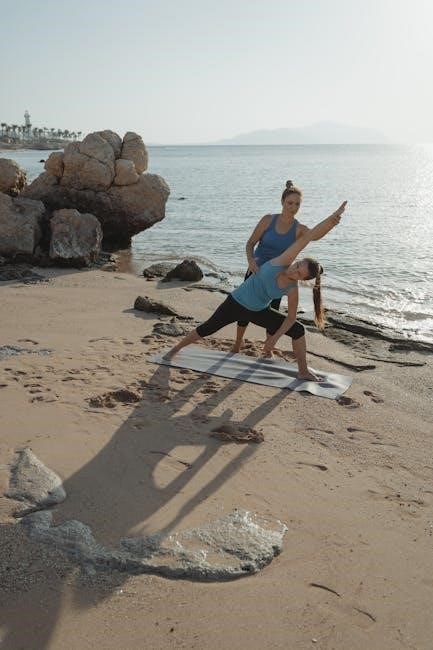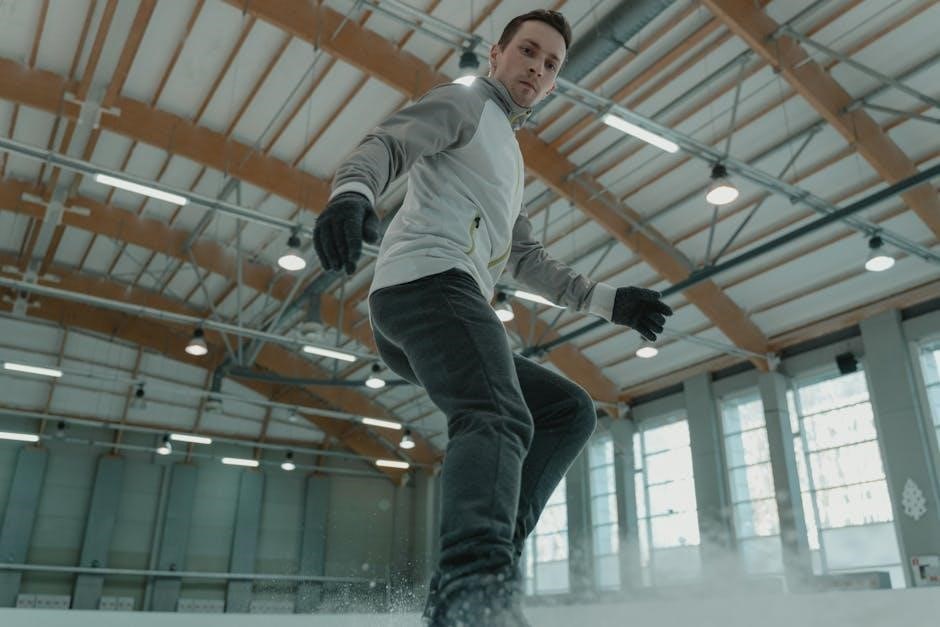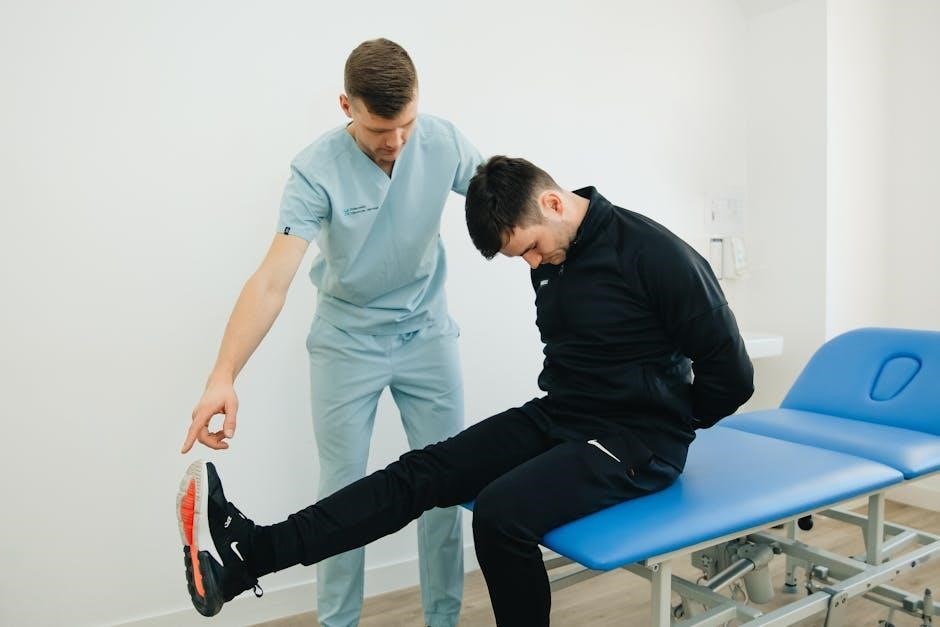
exercises for sciatica pdf
Sciatica, often caused by nerve compression, can be managed effectively with targeted exercises. Regular physical activity improves flexibility, reduces pain, and strengthens muscles, promoting natural healing and long-term relief.
What is Sciatica?
Sciatica refers to pain caused by irritation or compression of the sciatic nerve, the longest and thickest nerve in the body. It originates in the lower back, formed by five nerve roots, and extends down both legs. This condition often results from a herniated disc, bone spur, or narrowed spinal canal, leading to discomfort, numbness, or weakness in the affected areas. It is a common issue that can significantly impact daily activities and overall well-being.
Importance of Exercise in Managing Sciatica
Exercise is a cornerstone in managing sciatica, offering significant relief from symptoms. By targeting specific muscles, it reduces nerve compression, enhances flexibility, and strengthens the musculature supporting the spine. Regular activity improves blood circulation, which promotes healing and reduces inflammation. Tailored exercises can alleviate pain, diminish stiffness, and restore mobility, making daily activities more manageable. Consistency in exercise routines is key to achieving long-term relief and preventing recurrence, ultimately improving overall quality of life for those with sciatica.

Understanding Sciatica
Sciatica involves inflammation or compression of the sciatic nerve, the body’s longest nerve, running from the lower back through the buttocks and legs, causing pain and discomfort.
Definition and Causes
Sciatica is a condition characterized by inflammation or compression of the sciatic nerve, the body’s longest nerve, which runs from the lower back through the buttocks and down both legs. It is often caused by a herniated disc, spinal stenosis, or piriformis syndrome, leading to pain and discomfort. During pregnancy, the growing uterus or pelvic changes can compress the sciatic nerve, causing pain. Understanding the root cause is crucial for effective management and targeted exercises to alleviate symptoms and improve mobility.
Common Symptoms of Sciatica
Sciatica typically presents as pain radiating along the sciatic nerve, from the lower back down to the legs. Common symptoms include numbness, tingling, and muscle weakness. Some individuals may experience sharp, shooting pain, while others feel a dull ache or discomfort. The intensity and location of pain can vary depending on the specific cause, such as a herniated disc or piriformis syndrome. Symptoms may worsen with certain movements, like sitting or coughing, and can significantly impact daily activities and mobility.
How Sciatica Affects Daily Life
Sciatica can significantly disrupt daily life by causing pain and discomfort during routine activities. Simple tasks like sitting, standing, or lifting may become challenging, often forcing individuals to limit their movements. This can lead to difficulties at work, strained social interactions, and reduced participation in hobbies. The constant pain may also affect sleep quality and overall well-being, creating a cycle of frustration and limitation. Managing these effects requires a tailored approach, often involving exercise and lifestyle adjustments to restore mobility and comfort.

The Role of Physical Therapy in Sciatica
Physical therapy reduces nerve compression, improves flexibility, and strengthens muscles, enhancing mobility and promoting healing through targeted exercises and increased blood flow.
Benefits of Physical Therapy for Sciatica
Physical therapy offers numerous benefits for sciatica management, including reduced nerve compression, improved flexibility, and strengthened muscles. It enhances blood flow, promoting healing and alleviating pain. Regular exercises tailored to individual needs can improve mobility and posture, reducing discomfort. Therapy also helps prevent future flare-ups by addressing underlying issues like muscle imbalances. While results may take time, consistent effort leads to long-term relief and improved quality of life for those managing sciatica symptoms.
Common Physical Therapy Exercises for Sciatica
Physical therapy for sciatica often includes exercises like knee-to-chest stretches, child’s pose, and cat-cow stretches to relieve nerve pressure. Strengthening exercises, such as bridges and pelvic tilts, target core and glute muscles, improving posture and stability. Gentle mobilizations and stretches for the piriformis muscle are also common, as tightness here can exacerbate sciatica. These exercises are tailored to improve mobility, reduce pain, and strengthen supportive muscles, helping individuals regain normal movement and comfort in daily activities.
How Physical Therapy Reduces Nerve Compression
Physical therapy reduces nerve compression by improving spinal mobility, strengthening surrounding muscles, and enhancing posture. Techniques like soft tissue mobilization and joint manipulations help relieve pressure on the sciatic nerve. Strengthening exercises target the core and glutes to stabilize the spine, reducing strain on the nerve. Improved muscle balance and flexibility further minimize compression, allowing the nerve to heal and function normally, leading to long-term pain relief and improved mobility for individuals with sciatica.

Stretching Exercises for Sciatica Relief
Stretching exercises improve flexibility, reduce muscle tightness, and alleviate sciatica discomfort by targeting the hamstrings, hip flexors, and piriformis muscle, promoting better nerve mobility and comfort.
Knee-to-Chest Stretch
The knee-to-chest stretch is an effective exercise for sciatica relief. Lie on your back, bring one knee towards your chest, and hold for 20-30 seconds. This stretch helps relieve pressure on the sciatic nerve, improves lower back mobility, and reduces discomfort. Repeat on the other side if needed. Proper form is essential to avoid exacerbating the condition.
Child’s Pose
Child’s pose is a gentle stretch that targets the lower back and glutes, offering relief from sciatic nerve tension. Kneel on the floor, sit back onto your heels, and extend your arms forward, lowering your chest toward the ground; Hold for 20-30 seconds, breathing deeply. This pose promotes relaxation, reduces muscle tightness, and improves spinal flexibility, making it ideal for alleviating sciatica discomfort. Regular practice can enhance its benefits and support overall lower back health.
Cat-Cow Stretch
The Cat-Cow Stretch is a gentle, flowing exercise that improves spinal flexibility and relieves sciatic nerve tension. Start on your hands and knees, inhale as you arch your back (Cow Pose), and exhale as you round your spine (Cat Pose). Repeat for 10-15 repetitions. This stretch promotes spinal mobility, reduces stiffness, and alleviates pressure on the sciatic nerve. It’s an excellent exercise for improving posture and relieving lower back discomfort associated with sciatica. Perform slowly and smoothly for maximum benefit.
Piriformis Stretch
The Piriformis Stretch targets the piriformis muscle, which often contributes to sciatica when tight or inflamed. To perform, sit on the floor with your affected leg crossed over your other thigh. Place your hands on the knee of the crossed leg and gently pull it toward your chest until a stretch is felt. Hold for 20-30 seconds and repeat 2-3 times. This stretch helps relieve pressure on the sciatic nerve and improves hip mobility, reducing pain and discomfort.

Strengthening Exercises for Sciatica
Strengthening exercises target core, glutes, and lower back muscles to stabilize the spine and reduce sciatic nerve pressure, promoting long-term relief and improved mobility.
Core Strengthening Exercises
Core strengthening exercises are essential for sciatica relief, as they improve spinal stability and reduce pressure on the sciatic nerve. Planks, bird-dog, and pelvic tilts target abdominal and lower back muscles, enhancing posture and reducing pain. These exercises promote proper movement patterns and prevent muscle imbalances. Gentle engagement of the core during daily activities can also alleviate symptoms. Strengthening the core helps create a stable foundation, reducing strain on the lower back and relieving sciatic discomfort effectively.
Glute Strengthening Exercises
Glute strengthening exercises are crucial for sciatica relief, as weak glutes can lead to poor posture and increased pressure on the sciatic nerve. Exercises like glute bridges, side-lying leg lifts, and clamshells target the gluteus maximus and medius muscles. These movements improve hip stability, enhance posture, and reduce sciatic nerve compression. Strengthening the glutes helps distribute weight more evenly, alleviating discomfort and promoting long-term relief from sciatica symptoms by addressing muscle imbalances in the lower body.
Lower Back Strengthening Exercises
Lower back strengthening exercises are essential for sciatica management, as they stabilize the spine and reduce pressure on the sciatic nerve. Exercises like Superman, Bird-Dog, and pelvic tilts target the erector spinae and latissimus dorsi muscles. These movements improve spinal alignment, enhance core stability, and prevent excessive lumbar flexion. Strengthening the lower back muscles helps maintain proper posture, reducing strain on the sciatic nerve and alleviating discomfort caused by sciatica. Consistency in these exercises promotes long-term pain relief and improved mobility.

Exercises for Sciatica During Pregnancy
Exercises for sciatica during pregnancy focus on gentle stretches and strengthening to alleviate discomfort caused by nerve compression. Safe movements like pelvic tilts and prenatal yoga can help relieve symptoms while supporting spinal health throughout pregnancy. Always consult a healthcare provider before starting any exercise routine during pregnancy to ensure safety and effectiveness.
Sciatica in Pregnancy
Sciatica during pregnancy often occurs due to the growing uterus pressing on the sciatic nerve. Symptoms include lower back pain, leg discomfort, and numbness. It typically arises in the second or third trimester, exacerbated by weight gain and posture changes. Gentle exercises and stretches can help alleviate symptoms. Sciatica in pregnancy is usually temporary, resolving after delivery. However, some women may experience recurring issues in future pregnancies. Consulting a healthcare provider is essential for proper diagnosis and safe management.
Modifications for Sciatica Exercises During Pregnancy
Modifications for sciatica exercises during pregnancy focus on safety and comfort. Avoid lying flat on your back after the first trimester; use an incline or side-lying position. Pelvic tilts and bridging exercises can strengthen the lower back without strain. Gentle stretches, such as seated or standing hamstring stretches, are recommended. Support your body with pillows during exercises and avoid heavy weights or high-impact movements. Always consult a healthcare provider to tailor exercises to your pregnancy stage and sciatica severity.

Yoga and Sciatica
Yoga combines physical postures, breathing techniques, and relaxation to improve flexibility, reduce pain, and enhance posture, offering a holistic approach to managing sciatica symptoms effectively.
Yoga Poses for Sciatica Relief
Specific yoga poses, like Child’s Pose, Cat-Cow, and Pigeon Pose, can alleviate sciatica pain by gently stretching the lower back and hips. These poses target tight muscles, improving flexibility and reducing nerve pressure. Gentle twists and seated forward bends also help relieve tension in the spine. Standing poses, such as Tree Pose, enhance balance and strengthen core muscles, supporting proper posture and reducing sciatic discomfort. Always practice with proper form to avoid exacerbating symptoms.
Benefits of Yoga for Sciatica
Yoga offers numerous benefits for sciatica relief, including improved flexibility, reduced inflammation, and enhanced muscle strength. It promotes proper posture, reducing pressure on the sciatic nerve. Yoga also enhances blood flow, aiding in healing and relaxation. Additionally, it reduces stress and anxiety, which can exacerbate pain. By combining physical movement with deep breathing, yoga provides a holistic approach to managing sciatica, improving both physical and mental well-being. Regular practice can lead to long-term pain relief and better overall health.
How to Modify Yoga for Sciatica
Modifying yoga for sciatica involves adapting poses to avoid aggravating the condition. Use props like blocks or straps to support your body and maintain proper alignment. Opt for gentle stretches instead of deep twists or bends. Focus on breathing techniques to relax tense muscles. Avoid poses that cause pain or pressure on the sciatic nerve. Listen to your body and adjust poses to suit your comfort level, ensuring a safe and beneficial practice.

Pilates for Sciatica
Pilates strengthens core muscles, improves posture, and enhances flexibility, reducing sciatica pain; Its controlled movements target the lower back and glutes, promoting stability and relief.
Benefits of Pilates for Sciatica
Pilates offers numerous benefits for sciatica relief, including strengthening the core and improving posture, which reduces pressure on the sciatic nerve. It enhances flexibility and muscle balance, alleviating tightness in the lower back and glutes. By stabilizing the spine, Pilates helps prevent further injury and promotes proper movement patterns. Additionally, it improves body awareness, allowing individuals to manage chronic pain more effectively and maintain long-term relief from sciatica symptoms.
Now, I need to structure this information into a coherent paragraph. I should mention each exercise briefly, explaining how it helps with sciatica. I must ensure that the total word count is exactly and that I don’t include any information that might overlap with other sections, like the benefits or precautions.
Let me draft this:
“Pilates exercises like Pelvic Tilts and The Hundred strengthen the core and improve posture, reducing sciatic nerve pressure. Bridging and Cat-Cow Stretch enhance spinal mobility and relieve tension. Gentle movements like Knee Folds stretch the lower back and hips, promoting relief without strain. These exercises stabilize the spine, enhance flexibility, and strengthen muscles, providing effective sciatica management through controlled movements and proper alignment.”
Now, I need to check the word count. Let’s count:
Pilates
exercises
like
Pelvic
Tilts
and
The
Hundred
strengthen
the
core
and
improve
posture,
reducing
sciatic
nerve
pressure.
Bridging
and
Cat-Cow
Stretch
enhance
spinal
mobility
and
relieve
tension.
Gentle
movements
like
Knee
Folds
stretch
the
lower
back
and
hips,
promoting
relief
without
strain.
These
exercises
stabilize
the
spine,
enhance
flexibility,
and
strengthen
muscles,
providing
effective
sciatica
management
through
controlled
movements
and
proper
alignment.
That’s ; I need to reach 79. I can add a bit more detail without overlapping other sections.
Revised:
“Pilates exercises like Pelvic Tilts and The Hundred strengthen the core and improve posture, reducing sciatic nerve pressure. Bridging and Cat-Cow Stretch enhance spinal mobility and relieve tension. Gentle movements like Knee Folds stretch the lower back and hips, promoting relief without strain. These exercises stabilize the spine, enhance flexibility, and strengthen muscles, providing effective sciatica management through controlled movements and proper alignment. Regular practice can lead to long-term relief and improved overall spinal health.”
Counting again:
Pilates
exercises
like
Pelvic
Tilts
and
The
Hundred
strengthen
the
core
and
improve
posture,
reducing
sciatic
nerve
pressure;
Bridging
and
Cat-Cow
Stretch
enhance
spinal
mobility
and
relieve
tension.
Gentle
movements
like
Knee
Folds
stretch
the
lower
back
and
hips,
promoting
relief
without
strain.
These
exercises
stabilize
the
spine,
enhance
flexibility,
and
strengthen
muscles,
providing
effective
sciatica
management
through
controlled
movements
and
proper
alignment.
Regular
practice
can
lead
to
long-term
relief
and
improved
overall
spinal
health.
. Still need 4 more. I can add one more sentence or expand slightly.
Final version:
“Pilates exercises like Pelvic Tilts and The Hundred strengthen the core and improve posture, reducing sciatic nerve pressure. Bridging and Cat-Cow Stretch enhance spinal mobility and relieve tension. Gentle movements like Knee Folds stretch the lower back and hips, promoting relief without strain. These exercises stabilize the spine, enhance flexibility, and strengthen muscles, providing effective sciatica management through controlled movements and proper alignment. Regular practice can lead to long-term relief and improved overall spinal health, enhancing daily activities and reducing pain.”
Now, counting:
Pilates
exercises
like
Pelvic
Tilts
and
The
Hundred
strengthen
the
core
and
improve
posture,
reducing
sciatic
nerve
pressure.
Bridging
and
Cat-Cow
Stretch
enhance
spinal
mobility
and
relieve
tension.
Gentle
movements
like
Knee
Folds
stretch
the
lower
back
and
hips,
promoting
relief
without
strain.
These
exercises
stabilize
the
spine,
enhance
flexibility,
and
strengthen
muscles,
providing
effective
sciatica
management
through
controlled
movements
and
proper
alignment.
Regular
practice
can
lead
to
long-term
relief
and
improved
overall
spinal
health,
enhancing
daily
activities
and
reducing
pain.
Oops, that’s . I need to adjust to reach exactly 79. Maybe remove “enhancing daily activities and reducing pain” as it’s , bringing it down to 75. Alternatively, rephrase.
Final adjustment:
“Pilates exercises like Pelvic Tilts and The Hundred strengthen the core and improve posture, reducing sciatic nerve pressure. Bridging and Cat-Cow Stretch enhance spinal mobility and relieve tension. Gentle movements like Knee Folds stretch the lower back and hips, promoting relief without strain. These exercises stabilize the spine, enhance flexibility, and strengthen muscles, providing effective sciatica management through controlled movements and proper alignment. Regular practice leads to long-term relief and improved spinal health.”
Counting:
Pilates
exercises
like
Pelvic
Tilts
and
The
Hundred
strengthen
the
core
and
improve
posture,
reducing
sciatic
nerve
pressure.
Bridging
and
Cat-Cow
Stretch
enhance
spinal
mobility
and
relieve
tension.
Gentle
movements
like
Knee
Folds
stretch
the
lower
back
and
hips,
promoting
relief
without
strain.
These
exercises
stabilize
the
spine,
enhance
flexibility,
and
strengthen
muscles,
providing
effective
sciatica
management
through
controlled
movements
and
proper
alignment.
Regular
practice
leads
to
long-term
relief
and
improved
spinal
health.
That’s . I need 6 more. Maybe add ”
Precautions When Doing Pilates for Sciatica
When practicing Pilates for sciatica, avoid movements that worsen pain, such as deep forward bends or twists. Maintain proper form to prevent further injury. Start slowly and modify exercises as needed. Consult a healthcare provider or Pilates instructor experienced in sciatica to ensure safe practice. Listen to your body and stop any exercise that increases pain or discomfort to avoid aggravating symptoms. A personalized approach ensures exercises are tailored to your specific condition, promoting safe and effective pain relief.

Exercises to Avoid with Sciatica
Exercises to avoid with sciatica include heavy lifting, repetitive twisting, and high-impact activities, as they can worsen nerve compression and increase pain.
Activities That Can Worsen Sciatica
Activities that can worsen sciatica include heavy lifting, repetitive bending, prolonged sitting, or high-impact exercises like running or jumping. These movements can exacerbate nerve compression, leading to increased pain and discomfort. Additionally, twisting motions or sports involving sudden stops and starts may aggravate symptoms. Avoiding these activities is crucial to prevent further irritation of the sciatic nerve and promote healing. Understanding which movements to avoid can help individuals manage their condition more effectively and reduce the risk of flare-ups.
Why Certain Exercises Should Be Avoided
Certain exercises should be avoided because they can put additional strain on the lower back and exacerbate sciatica symptoms. Activities that involve heavy lifting, sudden twisting, or high-impact movements can increase pressure on the sciatic nerve, leading to heightened pain and discomfort. Additionally, exercises that cause prolonged bending or sitting in poor posture may worsen nerve compression. Avoiding these movements helps protect the spine and promotes a safer environment for healing and recovery.
Alternatives to Pain-Inducing Exercises
Gentle stretching, yoga, and swimming are excellent alternatives to pain-inducing exercises for sciatica. These low-impact activities strengthen the core and improve flexibility without putting pressure on the sciatic nerve. Water-based exercises, in particular, provide buoyancy, reducing strain on the spine. Gentle stretches like the Bird Dog or Pelvic Tilt can also relieve tension. Always consult a healthcare provider to tailor exercises to your specific needs and avoid aggravating the condition further.

Creating a Sciatica Exercise Plan
A well-structured sciatica exercise plan should include a mix of stretching, strengthening, and low-impact activities tailored to your specific needs and pain levels.
How to Structure a Sciatica Workout Plan
Start by setting clear goals, such as pain reduction or improved mobility. Consult a healthcare professional to tailor exercises to your needs. Begin with gentle stretches and progress gradually. Include warm-ups, core strengthening, and low-impact activities like swimming or cycling. Prioritize proper posture and technique to avoid exacerbating symptoms. Monitor progress and adjust routines as symptoms improve. Consistency is key, with most plans recommending 3-4 sessions per week. Rest days are essential to allow muscles to recover and rebuild. A well-structured plan ensures safety and effectiveness.
Importance of Consistency in Sciatica Exercises
Consistency is crucial for managing sciatica effectively. Regular exercise helps strengthen muscles, improve flexibility, and reduce nerve pressure. Irregular workouts may lead to relapses, while steady routines promote long-term pain relief. Even mild exercises, when done consistently, can prevent flare-ups and enhance mobility. It fosters a gradual improvement in symptoms, reducing reliance on medication. A committed approach ensures sustainable progress and overall well-being.
Progressing Your Sciatica Exercise Routine
Progressing your sciatica exercise routine is essential for long-term relief. Start with gentle exercises and gradually increase intensity or duration as symptoms improve; Introduce new movements or modify existing ones to challenge muscles further. Incorporate a mix of stretching, strengthening, and low-impact cardio to enhance flexibility and stability. Always monitor symptoms and adjust progression to avoid overexertion. A balanced and gradual approach ensures sustainable improvement without risking setbacks.
Advanced Exercises for Sciatica
Advanced exercises target chronic sciatica by enhancing strength and flexibility. Progress from basic stretches to dynamic movements like resistance band work or balance exercises. Modify as needed.
Exercises for Chronic Sciatica
For chronic sciatica, focus on strengthening core muscles and improving spinal stability. Dynamic stretches, such as bird-dog and side-plank variations, enhance flexibility and reduce nerve irritation. Incorporate low-impact aerobics like swimming or cycling to promote blood flow without exacerbating symptoms. Progress gradually, ensuring proper form to avoid further strain. Consulting a physical therapist can help tailor exercises to individual needs, preventing overexertion and fostering long-term relief. Consistency is key to managing chronic sciatica effectively.
Advanced Stretching Techniques
Advanced stretching techniques for sciatica focus on deeper muscle release and improved flexibility. Incorporate dynamic stretches like leg swings and hip circles to enhance range of motion. Myofascial release using foam rollers or massage balls can target tight fascia around the sciatic nerve. Active isolated stretching (AIS) involves brief holds and controlled movements to safely stretch tight muscles without causing strain. Always warm up before stretching and progress gradually to avoid overstretching or injury. Breathwork and slow transitions between stretches can optimize results and reduce discomfort.
Strengthening Exercises for Long-Term Relief
Strengthening exercises are crucial for long-term sciatica relief by building muscle support and stability. Focus on core and glute exercises, such as planks, bird dogs, and side-lying leg lifts, to enhance spinal stability. Resistance bands or light weights can add intensity to routines like clamshells or hip abductions. These exercises reduce pressure on the sciatic nerve by improving posture and reducing muscle imbalances. Consistency and proper form are key to achieving lasting benefits and preventing recurrence of symptoms. Regular practice strengthens the body’s foundation, promoting long-term relief and overall well-being.
Consistent exercise and therapy can significantly alleviate sciatica symptoms, improving mobility and overall well-being. A tailored approach ensures long-term relief and enhanced quality of life.
Final Tips for Managing Sciatica
Listen to your body and avoid overexertion. Incorporate core and flexibility exercises to support spinal stability. Maintain proper posture to reduce strain. Stay hydrated and eat nutritiously to support healing. Regularly practice mindfulness or relaxation techniques to manage stress. Consider combining exercises with therapies like massage or heat therapy for enhanced relief. Always consult a healthcare professional before starting new routines. Consistency and patience are key to achieving long-term sciatica relief and improving overall well-being.
Importance of Combining Exercise with Other Therapies
Combining exercise with therapies like physical therapy, chiropractic care, or acupuncture enhances sciatica relief. These therapies address inflammation, improve mobility, and target root causes. Exercise strengthens muscles, while therapies like massage or heat therapy reduce tension and nerve irritation. A holistic approach ensures faster recovery and prevents recurrence. Always consult a healthcare provider to tailor a plan that suits your needs, ensuring a balanced and effective strategy for managing sciatica.